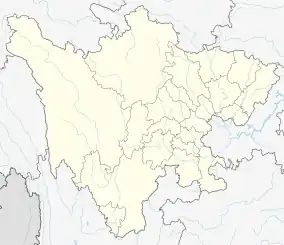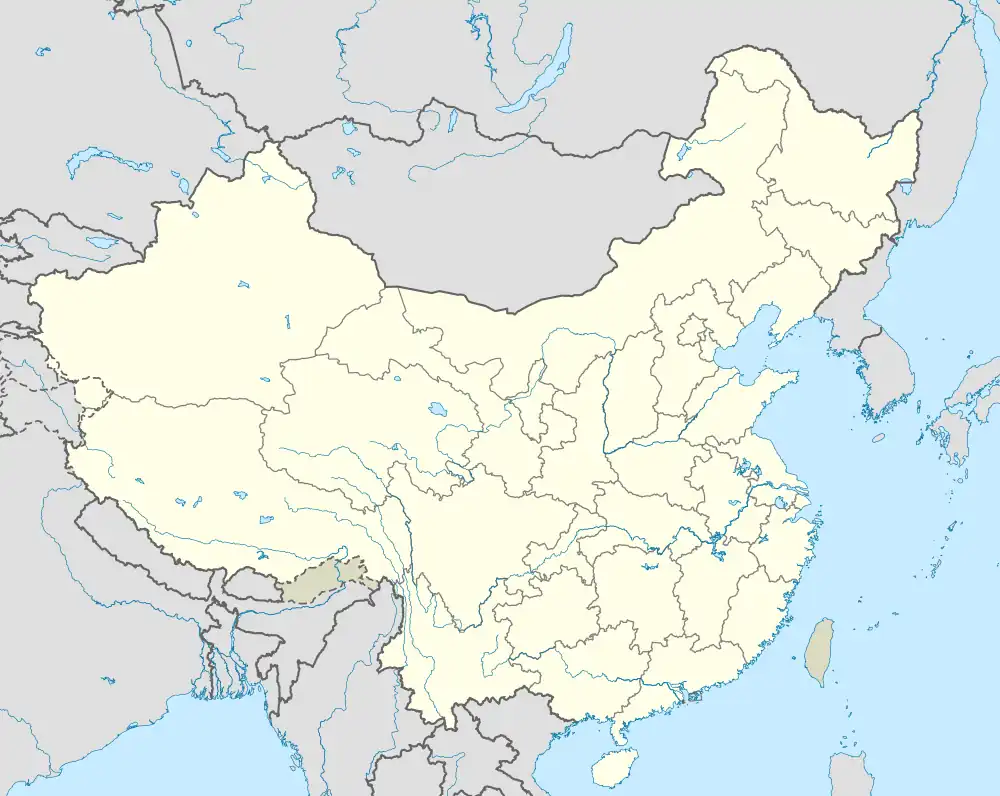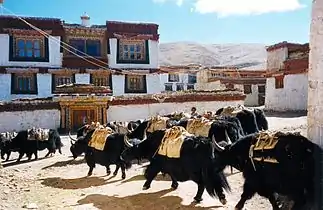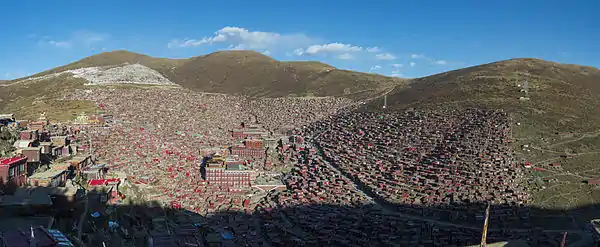Litang County
理塘县 • ལི་ཐང་རྫོང་། | |
|---|---|
.jpg.webp) Landscape of Litang County | |
.png.webp) Litang County (red) in Garzê Prefecture (yellow) and Sichuan | |
 Litang Location of the seat in Sichuan  Litang Litang (China) | |
| Coordinates (Litang County government): 29°59′39″N 100°16′09″E / 29.9942°N 100.2692°E | |
| Country | China |
| Province | Sichuan |
| Autonomous prefecture | Garzê |
| County seat | Tochong (Litang) |
| Area | |
| • Total | 13,677 km2 (5,281 sq mi) |
| Elevation | 3,954 m (12,972 ft) |
| Population (2020)[1] | |
| • Total | 67,293 |
| • Density | 4.9/km2 (13/sq mi) |
| Time zone | UTC+8 (China Standard) |
| Website | litang |
| Litang County | |||||||||||
|---|---|---|---|---|---|---|---|---|---|---|---|
| Chinese name | |||||||||||
| Simplified Chinese | 理塘县 | ||||||||||
| Traditional Chinese | 理塘縣 | ||||||||||
| |||||||||||
| Tibetan name | |||||||||||
| Tibetan | ལི་ཐང་རྫོང་། | ||||||||||
| |||||||||||
Litang (Tibetan: ལི་ཐང་རྫོང་།; Chinese: 理塘县) is in southwest of Garzê Tibetan Autonomous Prefecture, Sichuan, China.
Litang is part of Kham in the Tibetan cultural zone, and several famous Buddhist figures were born here, including the 7th Dalai Lama, the 10th Dalai Lama, the 11th Tai Situpa, four of the Pabalas, as well as the 5th Jamyang Zhépa of Labrang Monastery. Düsum Khyenpa, 1st Karmapa Lama, returned here and built Kampo Nénang Monastery and Pangphuk Monastery. It also has strong connections with the eponymous hero of the Epic of King Gesar.[2]
History

For nearly all of the county's recorded history, Litang's greatest concentration of population and center of political power has been Lithang Monastery, known formally as Ganden Thubchen Choekhorling. The town that is today the Litang County seat is adjacent to the monastery, which was originally a temple for worship of Bon. In A.D. 1580 it was converted to Gelug Buddhism by the 3rd Dalai Lama. In the centuries since, Litang Monastery has been damaged and rebuilt several times.[3] Lithang joined the Batang uprising together with Bathang in 1876, but failed, since then, Qing China started to rule this area directly.
During the 1950s, the region around Litang was one of the many areas of Tibetan armed resistance to rule of the Chinese Communist Party. A resistance group called the Chushi Gangdruk was active in the area. In 1956 the monastery was bombed by the PLA.[4] The October 5, 1956 edition of the Tibet Mirror newspaper printed a witness' drawing of this bombing of the Litang monastery, Jamchen Chokhor Ling and others by aircraft of the People's Liberation Army. The photo's caption in its original English is:
"They are killing several thousand of our freedom-loving, brave, ill-armed Khampas, with modern weapons; and distroying monasterees [sic]. The world is protesting the aggressor in Europe and W. Asia, but alas! There is no voice for Tibet."[5][6][7][8]
In August, 2007, the Litang Horse Festival was the scene of an impromptu anti-government political speech by Runggye Adak, which was followed by protests calling for his release. A crackdown officially described as "patriotic education campaign" followed in autumn of 2007, including several politically motivated arrests and attempts to force local Tibetans to denounce the 14th Dalai Lama.[9]
In 2013, one major temple of Lithang Monastery burned to the ground in an accidental fire.[10]
Geography

Litang County is located in the west of Sichuan, the southwest of Garze Tibetan Autonomous Prefecture, between the Jinsha River and the Yalong River on the southeastern edge of the Qinghai-Tibet Plateau. The Shaluli Mountains runs from north to south. The terrain is dominated by hill-shaped plateaus and mountain plains. The main mountain ranges are Ge'nyen Massif with an altitude of 6,204 meters, Xiaozha Mountain (肖扎山) with an altitude of 5,807 meters, Kainmêlong Mountain (mkhan me long, 克麦隆山) with an altitude of 5,780 meters and Kuergangzhong Mountain (库尔岗中山) with an altitude of 5,601 meters. The rivers in Litang County are divided into two major river systems, the Yalong River and the Jinsha River. There are 48 rivers with a drainage area of more than 100 square kilometers. Among them, 8 rivers including Wuliang River and Reyi River flow into the Yalong River, Naqu River and Lapo River. , Zhangna River three rivers into the Jinsha River.[11] Litang Town (the seat of the county) itself is located at an altitude of 4,014 metres. It is on open grassland and surrounded by snow-capped mountains and is about 400 meters higher than Lhasa, making it one of the highest towns in the world.[12]
Litang County has Haizi Mountain National Nature Reserve, Gemu County Nature Reserve, Xiaba Zhaga Sacred Mountain Nature Reserve, Wulianghe Provincial Wetland Park, and Zaraoxi Scenic Area. The ecological protection red line area is 7510.94 square kilometers, accounting for 52.33% of the county's total area and 10.77% of the state's ecological red line area. There are China's national second-class protected vegetable oil barley spruce and long-bud fir, and China's first-class protected animals include white-lipped deer, forest musk deer, horse musk deer, leopard, snow leopard, Chinese merganser duck, golden eagle, jade belt sea eagle, bearded vulture, bar-tailed Hazel Chicken, Sichuan Pheasant. China's second-class protected animals include macaques, Asian black bears, otters, lynx, golden cats, sambar, Tibetan gazelle, goral, blue sheep, argali, grassland eagle, and Tibetan horse chicken.[11]
The soils in Litang County are mainly alpine meadow soil, dark brown soil and alpine shrub meadow soil. There are 9 types and 13 sub-types. The forest area is 18,375.73 hectares, the county's forest coverage rate is 7.4%, the standing wood volume is 51,391,343 cubic meters, the main tree species are fir and spruce, the total area of natural grassland is 12,357,700 mu, the usable area is 9,891,600 mu, and the main forage species are There are alpine pine grass, Sichuan pine grass, black flower moss grass and so on.
Climate
With an elevation of nearly 4,000 metres (13,000 ft), Litang has an alpine subarctic climate (Köppen Dwc), with long, cold, dry winters, and short, cool summers with very frequent rain. The monthly 24-hour average temperature ranges from −4.9 °C (23.2 °F) in January to only 11.0 °C (51.8 °F) in July; the annual mean is 3.65 °C (38.6 °F). Over 80% of the 765 mm (30.1 in) of annual precipitation is delivered from June to September. With monthly percent possible sunshine ranging from 38% in July to 83% in December, the county seat receives 2,643 hours of bright sunshine annually, with winter by far the sunniest season.
| Climate data for Litang (1991–2020 normals, extremes 1971–2010) | |||||||||||||
|---|---|---|---|---|---|---|---|---|---|---|---|---|---|
| Month | Jan | Feb | Mar | Apr | May | Jun | Jul | Aug | Sep | Oct | Nov | Dec | Year |
| Record high °C (°F) | 17.4 (63.3) |
16.3 (61.3) |
21.6 (70.9) |
21.1 (70.0) |
23.9 (75.0) |
24.4 (75.9) |
25.9 (78.6) |
22.9 (73.2) |
23.1 (73.6) |
20.5 (68.9) |
17.1 (62.8) |
15.4 (59.7) |
25.9 (78.6) |
| Mean daily maximum °C (°F) | 4.4 (39.9) |
6.0 (42.8) |
8.3 (46.9) |
11.5 (52.7) |
15.4 (59.7) |
17.7 (63.9) |
17.4 (63.3) |
17.2 (63.0) |
16.0 (60.8) |
12.8 (55.0) |
8.5 (47.3) |
5.7 (42.3) |
11.7 (53.1) |
| Daily mean °C (°F) | −4.4 (24.1) |
−2.4 (27.7) |
0.4 (32.7) |
4.1 (39.4) |
8.3 (46.9) |
11.0 (51.8) |
11.3 (52.3) |
10.9 (51.6) |
9.4 (48.9) |
5.4 (41.7) |
−0.1 (31.8) |
−3.6 (25.5) |
4.2 (39.5) |
| Mean daily minimum °C (°F) | −11.4 (11.5) |
−9.2 (15.4) |
−5.6 (21.9) |
−1.9 (28.6) |
2.4 (36.3) |
6.3 (43.3) |
7.2 (45.0) |
6.9 (44.4) |
5.1 (41.2) |
0.2 (32.4) |
−6.5 (20.3) |
−10.7 (12.7) |
−1.4 (29.4) |
| Record low °C (°F) | −27.2 (−17.0) |
−22.0 (−7.6) |
−18.9 (−2.0) |
−12.5 (9.5) |
−7.5 (18.5) |
−3.7 (25.3) |
−2.0 (28.4) |
−2.5 (27.5) |
−5.5 (22.1) |
−12.9 (8.8) |
−19.7 (−3.5) |
−30.6 (−23.1) |
−30.6 (−23.1) |
| Average precipitation mm (inches) | 1.5 (0.06) |
4.8 (0.19) |
13.1 (0.52) |
29.9 (1.18) |
58.5 (2.30) |
146.0 (5.75) |
194.9 (7.67) |
161.2 (6.35) |
118.2 (4.65) |
31.6 (1.24) |
7.4 (0.29) |
1.8 (0.07) |
768.9 (30.27) |
| Average precipitation days (≥ 0.1 mm) | 2.1 | 4.1 | 8.0 | 11.9 | 14.2 | 20.7 | 24.6 | 22.8 | 20.1 | 9.8 | 4.4 | 2.2 | 144.9 |
| Average snowy days | 4.5 | 7.8 | 14.1 | 15.8 | 7.2 | 0.9 | 0.1 | 0.3 | 1.3 | 8.3 | 6.7 | 3.9 | 70.9 |
| Average relative humidity (%) | 38 | 42 | 48 | 52 | 55 | 66 | 73 | 73 | 71 | 60 | 49 | 41 | 56 |
| Mean monthly sunshine hours | 259.7 | 231.8 | 248.4 | 228.2 | 235.1 | 186.4 | 161.9 | 168.3 | 177.7 | 233.4 | 251.0 | 261.0 | 2,642.9 |
| Percent possible sunshine | 81 | 74 | 67 | 59 | 56 | 45 | 38 | 41 | 48 | 66 | 79 | 83 | 60 |
| Source 1: China Meteorological Administration[13][14] | |||||||||||||
| Source 2: Weather China[15] | |||||||||||||
Administrative divisions
Litang County administers 7 towns and 15 townships.[16] The seat of the county is Litang Town (officially: Gaocheng), which is located at an altitude of 4,014 metres. It is on open grassland and surrounded by snow-capped mountains and is about 400 meters higher than Lhasa, making it one of the highest towns in the world.[17]
| Name | Simplified Chinese | Hanyu Pinyin | Tibetan | Wylie | Administrative division code | |
|---|---|---|---|---|---|---|
| Towns | ||||||
| Tochong Town (Gaocheng, Litang) |
高城镇 | Gāochéng Zhèn | མཐོ་གྲོང་གྲོང་རྡལ། | mtho grong grong rdal | 513334100 | |
| Jawa Town (Jiawa) |
甲洼镇 | Jiǎwā Zhèn | འཇའ་བ་གྲོང་རྡལ། | ʼjaʼ ba grong rdal | 513334101 | |
| Gê'nyên Town (Genie) |
格聂镇 | Géniè Zhèn | དགེ་བསྙེན་གྲོང་རྡལ། | dge bsnyen grong rdal | 513334102 | |
| Mola Town (Mora, Mula) |
木拉镇 | Mùlā Zhèn | མོ་ལ་གྲོང་རྡལ། | mo la grong rdal | 513334103 | |
| Kyongba Town (Junba) |
君坝镇 | Jūnbà Zhèn | གྱོང་པ་གྲོང་རྡལ། | gyong pa grong rdal | 513334104 | |
| Nabo Town (Labo) |
拉波镇 | Lābō Zhèn | སྣ་པོ་གྲོང་རྡལ། | sna po grong rdal | 513334105 | |
| Qowo Town (Juewu) |
觉吾镇 | Juéwú Zhèn | ཇོ་བོ་གྲོང་རྡལ། | jo bo grong rdal | 513334106 | |
| Townships | ||||||
| Lhayü Township (Hayi) |
哈依乡 | Hāyī Xiāng | ལྷ་ཡུལ་ཤང་། | lha yul shang | 513334201 | |
| Boba Township (Moba) |
莫坝乡 | Mòbà Xiāng | འབོ་པ་ཤང་། | 'bo pa shang | 513334203 | |
| Yarxog Township (Yahuo) |
亚火乡 | Yàhuǒ Xiāng | ཡར་ཤོག་ཤང་། | yar shog shang | 513334203 | |
| Rongba Township | 绒坝乡 | Róngbà Xiāng | རོང་པ་ཤང་། | rong pa shang | 513334205 | |
| Gawa Township | 呷洼乡 | Gāwā Xiāng | དགའ་བ་ཤང་། | dga' ba shang | 513334206 | |
| Boingor Township (Benge) |
奔戈乡 | Bēngē Xiāng | དཔོན་སྒོར་ཤང་། | dpon sgor shang | 513334207 | |
| Cêngoin Township (Cunnge) |
村戈乡 | Cūngē Xiāng | ཚེ་མགོན་ཤང་། | tshe mgon shang | 513334208 | |
| Hornying Township (Heni) |
禾尼乡 | Héní Xiāng | ཧོ་སྙིང་ཤང་། | ho snying shang | 513334209 | |
| Qoidên Township (Qudeng) |
曲登乡 | Qǔdēng Xiāng | མཆོད་རྟེན་ཤང་། | mchod rten shang | 513334210 | |
| Mola Doiba Township (Shangmula) |
上木拉乡 | Shàngmùlā Xiāng | མོ་ལ་སྟོད་པ་ཤང་། | mo la stod pa shang | 513334213 | |
| Cosum Township (Zhuosang) |
濯桑乡 | Zhuósāng Xiāng | ཚོ་གསུམ་ཤང་། | tsho gsum shang | 513334216 | |
| Zamba Township (Zangba) |
藏坝乡 | Zàngbà Xiāng | འཛམ་པ་ཤང་། | 'dzam pa shang | 513334218 | |
| Kêmo Township (Kaimo, Gemu) |
格木乡 | Gémù Xiāng | གེ་མོ་ཤང་། | ge mo shang | 513334219 | |
| Mawa Township (Mêwa, Maiwa) |
麦洼乡 | Màiwā Xiāng | དམའ་བ་ཤང་། | dma' ba shang | 513334221 | |
| Dêwang Township (Dêwo, Dewu) |
德巫乡 | Déwū Xiāng | བདེ་དབང་ཤང་། | bde dbang shang | 513334222 | |
Social
According to China's seventh national census in 2020, Litang County has a total population of 67,293 people,[18] of which 51.56% are male and 48.44% are female, with a sex ratio of 106.42.[19] 27.8% were aged 0–14, 63.44% were aged 14–59, 8.76% were aged over 60, and 6.18% were aged over 65.[20] University education accounted for 8.603%, high school education accounted for 4.714%, junior high school education accounted for 10.05%, and primary school education accounted for 38.335% .[21]
In 2021, the resident population of Litang County is 74,740, of which the registered population is 68,202. The urbanization rate is 39.19%. Most of them are Tibetans, and there are Han, Mongolian, Hui, Naxi, Tujia, Yi, Miao and Qiang nationalities , Litang people traditionally live on herding, and the tourism industry has gradually developed since the reform and opening up.[22][23]
In 2020, the GDP of Litang County will reach 1.96275 billion yuan, the industrial added value will be 137.57 million yuan, the total investment in fixed assets of the whole society will be 1.21468 billion yuan, the total retail sales of consumer goods will be 843.62 million yuan, and the per capita disposable income of urban residents will be 39,343 yuan. , the per capita disposable income of rural residents is 13,009 yuan.[24] On February 18, 2020, the Sichuan Provincial Government approved the withdrawal of Litang County from poverty-stricken counties.[25]
Transport
Notable persons
- Lobsang Jigme Thubten Chökyi Nyima, the 6th Jamyang Zhepa
- Gompo Tashi Andrugtsang, leader of Chushi Gangdruk
- Pagbalha Geleg Namgyai, Chinese politician
- Runggye Adak, Tibetan activists
- Tenzing Tsondu, Internet celebrity
Notes
- ↑ "甘孜州第七次全国人口普查公报(第二号)" (in Chinese). Government of Garzê Prefecture. 2021-06-04.
- ↑ Mayhew, Bradley and Kohn, Michael. (2005). Tibet. 6th Edition, p. 260. Lonely Planet. ISBN 1-74059-523-8.
- ↑ https://www.pamela-logan.com/history/lithang-monastery-cycles-of-destruction-and-renewal/"Lithang Monastery: Cycles of Destruction and Renewal"
- ↑ Li, Jianglin (2016). Tibet in agony : Lhasa 1959. Wilf, Susan. Cambridge, Massachusetts: Harvard University Press. pp. Photo# 11 between pages 82 and 83. ISBN 9780674088894. OCLC 946579956.
- ↑ Li, Jianglin (2016) [5 October 1956]. Tibet in agony : Lhasa 1959. Translated by Wilf, Susan. Cambridge, Massachusetts: Harvard University Press. pp. Photo# 11 (of original drawing) between pages 82 and 83. ISBN 9780674088894. OCLC 946579956.
They are killing several thousand of our freedom-loving, brave, ill-armed Khampas, with modern weapons; and distroying monasterees [sic]. The world is protesting the aggressor in Europe and W. Asia, but alas! There is no voice for Tibet.
- ↑ Tharchin, Dorje (1956). Yul phyogs so soʾi gsar ʾgyur me loṅ (Tibet Mirror) (in Tibetan and English). Columbia University Libraries. Kalimpong, India: The Tibet Mirror Press. pp. Volume XXIII, Number 11, page 4.
- ↑ Li, Jianglin; 江月 (2010). 1959 Lasa! (in Chinese) (Chu ban ed.). Hong Kong: Xin shi ji chu ban ji chuan mei you xian gong si/ New Century Media & Consulting Co. Ltd. pp. 4th page of photos before the text. ISBN 9789881943019. OCLC 671634540.
- ↑ Li, Jianglin; 李江琳 (2010). 1959 Lasa! : Dalai Lama ru he chu zou (in Chinese) (Er ban ed.). Taipei City, Taiwan: Linking Publishing Company. pp. from photo gallery nested within text. ISBN 9789570848090. OCLC 972336063.
- ↑ "Crackdown in eastern Tibet."
- ↑ https://www.rfa.org/english/news/tibet/blaze-11172013105231.html "Tibetan Monastery Suffers ‘Massive Damage’ in Blaze"
- 1 2 理塘县人民政府 (2021-08-12). "自然环境". Retrieved 2022-07-04.
- ↑ Buckley, Michael and Straus, Robert. (1986) Tibet: a travel survival kit, p, 219. Lonely Planet Publications. South Yarra, Victoria, Australia. ISBN 0-908086-88-1.
- ↑ 中国气象数据网 – WeatherBk Data (in Simplified Chinese). China Meteorological Administration. Retrieved 13 April 2023.
- ↑ 中国气象数据网 (in Simplified Chinese). China Meteorological Administration. Retrieved 13 April 2023.
- ↑ 理塘 - 气象数据 -中国天气网 (in Chinese). Weather China. Retrieved 27 November 2022.
- ↑ 理塘县人民政府 (2021-08-12). "行政区域". Retrieved 2022-07-04.
- ↑ Buckley, Michael and Straus, Robert. (1986) Tibet: a travel survival kit, p, 219. Lonely Planet Publications. South Yarra, Victoria, Australia. ISBN 0-908086-88-1.
- ↑ "甘孜州第七次全国人口普查公报[1](第二号)". 甘孜藏族自治州人民政府. 2021-06-04. Retrieved 2022-06-18.
- ↑ "甘孜州第七次全国人口普查公报[1](第三号)". 甘孜藏族自治州人民政府. 2021-06-04. Retrieved 2022-07-05.
- ↑ "甘孜州第七次全国人口普查公报[1](第四号)". 甘孜藏族自治州人民政府. 2021-06-04. Retrieved 2022-07-05.
- ↑ "甘孜州第七次全国人口普查公报[1](第五号)". 甘孜藏族自治州人民政府. 2021-06-04. Retrieved 2022-07-05.
- ↑ "【理塘】四川美少年丁真鄉下成旅遊熱點!推薦6間甘孜超靚民宿". 香港01. 2021-01-08. Archived from the original on 2021-11-04. Retrieved 2022-01-16.
- ↑ 理塘县人民政府 (2021-08-12). "人口民族". Retrieved 2022-07-04.
- ↑ "2020年理塘县主要经济指标完成情况". 理塘县人民政府. 2021-01-10. Retrieved 2022-07-05.
- ↑ "四川省人民政府 关于批准叙永县等31个县(市)退出贫困县的通知 川府函〔2020〕33号". 四川省人民政府. 2020-02-18. Retrieved 2022-07-05.

